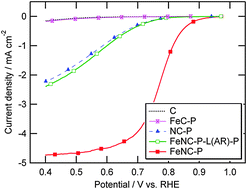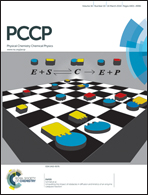Impact of transition metal on nitrogen retention and activity of iron–nitrogen–carbon oxygen reduction catalysts
Abstract
Iron based nitrogen doped carbon (FeNC) catalysts are synthesized by high-pressure pyrolysis of carbon and melamine with varying amounts of iron acetate in a closed, constant-volume reactor. The optimum nominal amount of Fe (1.2 wt%) in FeNC catalysts is established through oxygen reduction reaction (ORR) polarization. Since the quantity of iron used in FeNCs is very small, the amount of Fe retained in FeNC catalysts after leaching is determined by UV-VIS spectroscopy. As nitrogen is considered to be a component of active sites, the amount of bulk and surface nitrogen retention in FeNC catalysts are measured using elemental analysis and X-ray photoelectron spectroscopy, respectively. It is found that increasing nominal Fe content in FeNC catalysts leads to a decreased level of nitrogen retention. Thermogravimetric analysis demonstrates that increasing nominal Fe content leads to increased weight loss during pyrolysis, particularly at high temperatures. Catalysts are also prepared in the absence of iron source, and with iron removed by washing with hot aqua regia post-pyrolysis. FeNC catalysts prepared with no Fe show high retained nitrogen content but poor ORR activity, and aqua regia washed catalysts demonstrate similar activity to Fe-free catalysts, indicating that Fe is an active site component.


 Please wait while we load your content...
Please wait while we load your content...